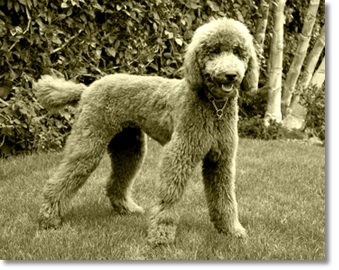 ABOUT PUPPY MOUTHING (Nipping your hand with those razor sharp teeth!)
ABOUT PUPPY MOUTHING (Nipping your hand with those razor sharp teeth!)
THE most important things you can teach your pup are “Come”, “Wait”, “Stay”,”Don’t” and BITE INHIBITION.
A perfect “heel”, “sit”, or “shake hands”, are of little value when your pup runs into the street and is hit by a car.
“Come”, (approach your person’s loving arms without fear of ANY punishment), “Wait”, (Do not cross the threshold until your person tells you), and “Stay”, (Freeze in position, do not move until your person releases you), “Don’t”, (Do not pick up stuff from the ground/floor), are self explanatory.
BITE INHIBITION, however is not very well understood, even by most trainers and veterinarians.
RULE NUMBER ONE REGARDING BITE INHIBITION: WHEN YOUR PUPPY GRABS YOUR HAND,
NEVER, NEVER, NEVER, put your hand around his muzzle, shake it, and yell “No Bite!”
NEVER, NEVER, NEVER, stick your fingers in the back of your pup’s mouth until he gags.
NEVER, NEVER, NEVER, jab your finger nail into your dog’s tongue.
These very old, harsh techniques are taught by people who do not understand a puppy’s NEED to mouth your hand. These techniques teach your dog only one thing…. that human hands are not trustworthy. Once you’ve done this, when you extend your hand for your pup to come to you, he will not trust it and may not come to you. This could cost him his life!!
WHY DOES YOUR PUPPY NEED TO MOUTH YOUR HAND? Puppies go through several stages before they are six months of age. The first step is an “Observation” stage. When you take your pup into your home, everything is new and different from what he just left. His litter mates are not there. His mum is not there. His previous human is not there. It is often very daunting for the pup, so he quietly observes his new surroundings, attempting to understand them. At this point, most new owners believe that they have the perfect dog who will not need any training. This is a tragic, erroneous assumption which often leads to a disastrous end to the dog’s life. More than 60% of dogs born in this country do not live to celebrate their second birthdays! Most dogs relinquished to shelters are relinquished due to “behavioral problem” that could have been prevented with a little early training……especially BITE INHIBITION !
When your pup has been in your home for a bit, he moves into the “Investigation” stage. He begins to feel a little more comfortable and ventures away from you, his crate, his bed, to see what else there is in this new environment. During the Investigation stage, he uses all five of his senses. He Investigates how things Look, Sound, Smell, Feel, and Taste. He is especially interested in how YOU look, sound, smell, feel and taste. The parts of your body that are the most accessible to your pup are your hands and ankles. When you handle your pup, scratching, petting, picking him up etc., your pup investigates how your hands look, sound, smell, feel and taste. Punishing him for accidentally investigating with too much enthusiasm is unfair and counterproductive!
When your pup becomes more comfortable in your home, and has observed and investigated the goings on, he moves into the “Experimental” stage. At this point, he will begin ‘testing’ his observations and investigations to see if what he has learned is accurate and reliable. One of the ‘tests’ is to see how you react to his behavior, what it takes to have his needs met and if you will play with him as did his litter mates.
WHAT IS BITE INHIBITION? All dogs bite. Every dog in this world will bite someone or something at some time in his life. That is a simple fact. Most bites are accidental. Your dog grabs for a treat you are about to give him and he catches your hand by accident. He grabs for a toy you are about to throw and gets your arm instead. While playing Tug Of War with your dog, he grabs at the toy for a better purchase and gets your hand by accident.
How much damage he does to your body part will be determined by how good is his Bite Inhibition. That is, when he grabs hold of you, does he know enough to INHIBIT THE FORCE with which he grabs you and does he know enough to RELEASE IMMEDIATELY. That is Bite Inhibition!
The time to teach your pup Bite Inhibition is when he is engaged in play biting. The purpose for play biting is to help your puppy learn how much pressure is acceptable and how much is not. When puppies play in litters or play groups, they grab each other with their sharp little teeth….sometimes very hard. They grab each other’s ears, tails, legs, feet, anything that is available. Again, they are Investigating and Experimenting, learning how much force is acceptable. Puppies usually grab ears because they are the most easily caught. Puppies’ jaws are relatively weak at this age so their bites do little damage. When one pup bites another with enough force to cause pain, the bitten pup squeals loudly and walks away from the biter. The biting puppy immediately approaches the puppy he has bitten and apologizes by licking and nuzzling his playmate in an effort to appease his playmate. They then return to play and THE BITER HAS LEARNED THAT HIS FORCE WAS TOO GREAT, and unacceptable to the bitten pup. Because he does not want to hurt his playmate he eventually learns to INHIBIT the strength of his bite when he grabs the other puppy’s ear. Through this trial and error, your pup learns not to bear down when he bites. If you punish your pup’s mouthing by the harsh methods mentioned above, you may stop your pup from biting you at the moment, but you have NOT taught him to inhibit the strength of his bite when he accidentally grabs your hand, or the hand or face of a small child. Because you have failed to teach him this critical lesson, a child may be accidentally, seriously injured and your dog may lose his life.
The theory behind taking puppies from their litters at eight weeks is that we must get on with teaching dogs how to get on with humans. If we take the pups from the safety of their mums and littermates before eight weeks, we risk traumatizing them causing them to become insecure through adulthood. If we take them at eight weeks, they have not yet had ample opportunity to learn Bite Inhibition from their littermates. The solution to this Catch-22 is that WE must teach our pups Bite Inhibition.
HOW DO I TEACH MY PUP BITE INHIBITION?
World-renowned Veterinarian and Behaviorist, Dr. Ian Dunbar, teaches the four steps of Bite Inhibition.
Step 1= No Pain. Step 2 = No Pressure. Step 3 = Release body part. Step 4 = Don’t initiate mouthing
Note: It is CRITICAL that you progress through these steps in order. You must NOT skip any step.
Step 1. Allow your pup to ‘mouth’ your hand. Do not allow him to ‘hurt’ your hand. As puppies yelp to tell their playmates that they are playing too roughly, you must do the same. Your yelp should be high pitched and loud enough to surprise but not frighten your pup. If your pup is a little older and you have missed the window of opportunity, you can still teach him Bite Inhibition. Problem is that older puppies often see the yelping as a game and go after you more energetically. If this happens, yelp, then immediately get up and walk into another room, closing the door or baby gate behind you. Do not pick up your pup and put him into his pen. Moving him will cause a disconnect between the hard bite and the correction. Your pup will not put together the correction of being moved into his pen with the bite. Walking away from him the moment he bites hard and you yelp, imitates the behavior that his littermates performed when he bit their ears too hard! When your pup is reliably mouthing you without hurting you, start Step 2.
Step 2. Allow your pup to ‘mouth’ your hand. Do not allow him to apply any ‘pressure’ on your hand. If your pup applies any pressure at all on your hand, again, yelp. If he thinks it’s a game, get up and walk away. NEVER become angry and punish your pup. Especially do not put him into his crate as a punishment . His crate must be his sanctuary! Never shove him in or pull him out of his ‘Safe Zone’! When your pup is reliably mouthing without any pressure, start Step 3.
Step 3. Teach your pup to “drop it”. Then, when he takes hold of your hand, gently tell your pup to “drop it”. Be gentle and calm when you teach him this cue. Again, you are teaching him appropriate behavior around humans, not punishing him for acting like a normal puppy!!! You want him to think about what you’ve asked him to do and praise him when he does it. That way, when he accidentally grabs you, he will realize that that is part of your body in his mouth and he will drop it on his own. When he reliably releases your hand on his own, when he mouths you, start Step 4.
Step 4. Teach him “don’t”. Then, when he is about to take hold of your hand, gently, softly tell him “don’t”. He should turn away from your hand.
If you are diligent about these exercises and do not punish your pup for mouthing in any way, you will have a gentle dog who trusts you and your hands. If you simply punish his normal, natural, investigatory and experimental mouthing, you will have an adult dog who has no idea how much pressure is acceptable, does not know to release your arm, leg, hand when he has grabbed it and may result in a serious injury.
Please print this and give it to your puppy sitter, groomer and veterinarian! Do not allow ANYONE to cause your dog to accidentally, seriously injure someone and lose his life.

